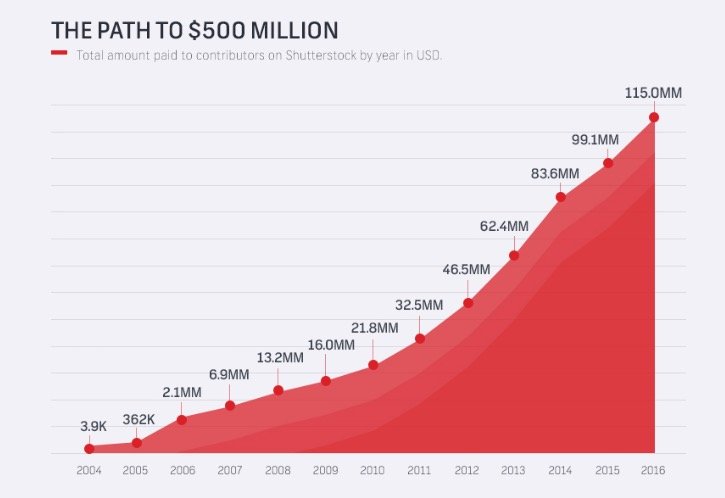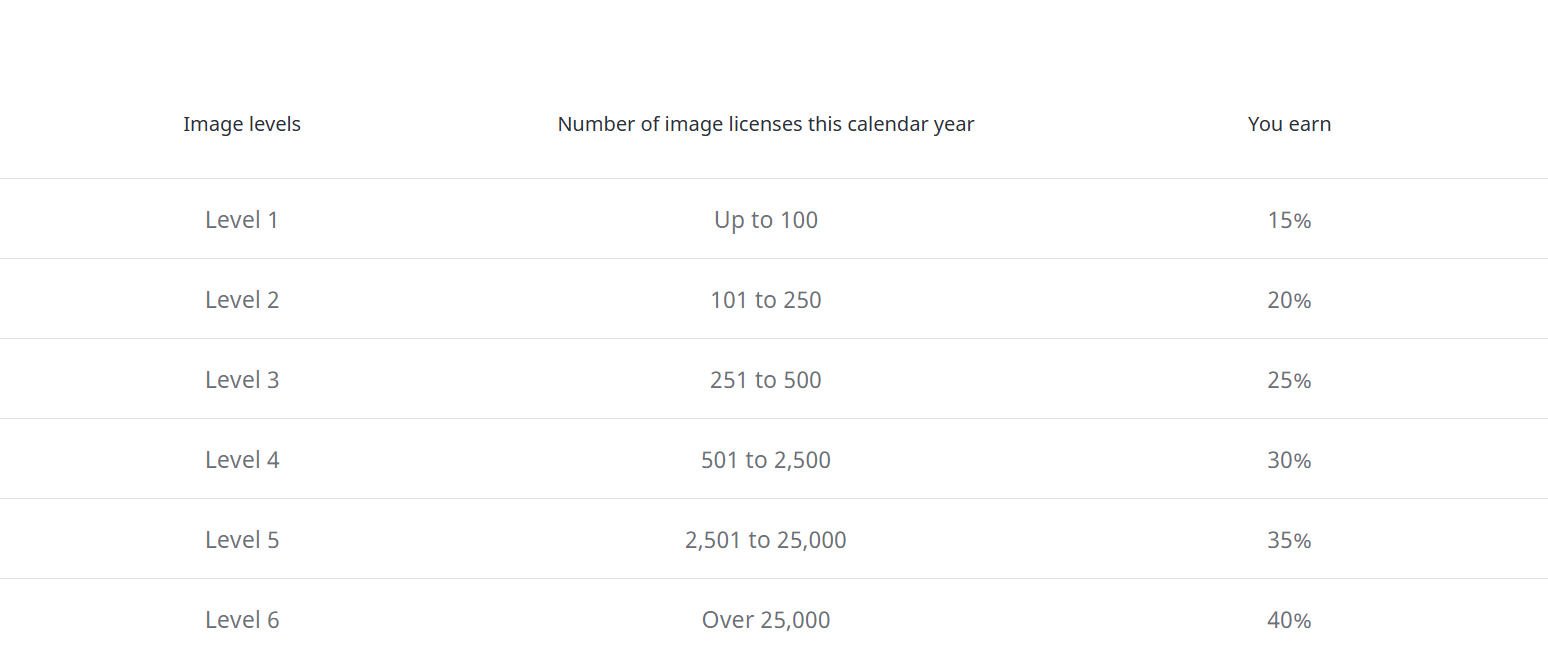Hey there, fellow photographers and curious readers! If you’re diving into the world of stock photography or already have your work uploaded on Shutterstock, you probably want to know how much you can earn in 2025. Well, the good news is that Shutterstock continues to be a popular platform for photographers to showcase their talents and make some extra income. But, like anything, your earnings depend on a bunch of factors. In this post, we’ll explore the latest trends, what to expect this year, and how you can maximize your earnings on
Factors Influencing Photographers’ Income on Shutterstock

When it comes to earning money on Shutterstock, a lot of things can influence how much you make. It’s not just about uploading good photos; it’s about understanding the landscape and what buyers are looking for. Here are some key factors that can impact your income:
- Image Quality and Relevance: High-resolution, well-composed, and relevant images tend to sell better. Shutterstock’s algorithms favor photos that meet current market needs, so keep an eye on trending topics and styles.
- Keywording and Metadata: Properly tagging your images with accurate and descriptive keywords makes them easier to find. Think of keywords as the GPS that guides buyers right to your photos.
- Portfolio Size and Diversity: The more quality images you have, the higher your chances of sales. A diverse portfolio catering to different themes and seasons can attract a broader audience.
- Upload Frequency and Consistency: Regular uploads keep your profile active and can boost your visibility. Shutterstock favors contributors who stay consistent over time.
- Market Trends and Demand: Staying on top of what’s hot—be it remote work, sustainability, or health—can help you create images that sell better. Research what buyers are currently searching for.
- Exclusive vs. Non-Exclusive Content: Exclusive contributors often earn higher royalties but commit to only selling on Shutterstock. Non-exclusive images might sell less per download but can be uploaded to multiple platforms, increasing overall income.
Understanding these factors can help you strategize and optimize your efforts. Remember, earning on Shutterstock isn’t just about luck; it’s about smart work, continuous learning, and adapting to market needs. Keep experimenting, stay updated with platform changes, and most importantly, enjoy the creative process!
Average Earnings for Shutterstock Contributors in 2025

So, you’re curious about how much photographers are actually making on Shutterstock in 2025? Well, the answer can vary quite a bit depending on a few key factors, but let’s break down the general picture.
On average, Shutterstock contributors earn around $200 to $400 per month if they’re consistently uploading quality content and engaging with the platform. Some top contributors, those with a large portfolio of high-demand images, can earn well over $1,000 per month. But keep in mind, these figures are averages — your earnings might be lower or higher depending on your niche, the quality of your images, and how often you upload.
To give you a clearer picture, here’s a quick breakdown:
| Earnings Range | Number of Contributors | Notes |
|---|---|---|
| $0 – $50/month | Many newcomers or occasional uploaders | Usually due to low upload volume or niche saturation |
| $50 – $200/month | Moderate contributors | Consistent uploaders with some popular images |
| $200 – $1,000+/month | Top contributors | High upload volume, popular niches, or exclusive content |
It’s also worth noting that Shutterstock’s royalty rates can fluctuate based on your contributor level and licensing options. For example, exclusive contributors tend to earn higher percentages, which can boost your overall income. Plus, the earning potential grows as you build a larger, more diverse portfolio that appeals to buyers across different markets.
In the end, while some photographers see quick wins, others focus on steady growth over time. The key takeaway? Consistency and quality are your best friends when it comes to increasing your earnings on Shutterstock in 2025.
Tips to Maximize Your Revenue as a Shutterstock Photographer

Looking to boost your income on Shutterstock? You’re in the right place. There are plenty of simple, effective strategies you can implement to make your images work harder for you. Let’s walk through some of the most valuable tips.
1. Focus on High-Demand Niches
Research what buyers are searching for. Trends can change, but some niches consistently perform well, like business, technology, health, and lifestyle images. Use Shutterstock’s search data or trending topics to guide your content creation. If you’re passionate about a niche, your enthusiasm will shine through in your photos, making them more appealing.
2. Upload Consistently
Frequency matters. The more quality images you upload, the higher your chances of appearing in search results. Set aside dedicated time each week to upload new content. Remember, Shutterstock favors active contributors, and regular uploads can lead to more exposure and sales.
3. Optimize Your Keywords and Titles
Think of keywords as your images’ GPS. Use relevant, specific tags that accurately describe your photos. Avoid keyword stuffing, but include all pertinent details like location, subject, mood, and color. Well-optimized titles and keywords make it easier for buyers to find your images, increasing your chances of sales.
4. Diversify Your Portfolio
Don’t put all your eggs in one basket. Cover a variety of subjects, styles, and themes. This way, you can attract different types of buyers and reduce dependence on a single niche. Plus, a diverse portfolio demonstrates your versatility as a photographer, which can lead to more opportunities.
5. Consider Exclusive Content
While non-exclusive images can be uploaded to multiple platforms, going exclusive with Shutterstock can boost your earnings per download. Exclusive contributors often earn higher royalty rates and get prioritized in search results. If you have a unique, high-quality niche, exclusivity might be worth considering.
6. Keep Up with Trends and Seasonal Content
Stay ahead of the curve by creating content around current events, seasons, holidays, or trending topics. Buyers often search for seasonal imagery months in advance, so planning ahead can lead to more sales. For example, creating Christmas-themed images in September or holiday travel shots in October can pay off big time.
7. Engage with the Community and Platform Features
Participate in Shutterstock’s contributor forums and utilize platform tools to learn from others, get feedback, and stay inspired. Sometimes, small tweaks based on community advice can dramatically improve your image visibility and sales.
By combining these strategies with your passion and creativity, you’ll be well on your way to maximizing your Shutterstock revenue in 2025. Remember, patience and persistence are key — keep refining your approach, and your earnings will grow over time!
Understanding Shutterstock’s Payment Structure and Royalties

If you’re diving into the world of stock photography on Shutterstock, one of the first things you’ll want to get a grip on is how they pay their contributors and how royalties work. It might seem a bit complex at first, but once you understand the basics, it’s easier to plan your photography strategy and set your expectations.
Shutterstock uses a royalty-based system, which means you earn a percentage of the sale price whenever someone licenses one of your images. The amount you earn per download depends largely on your contributor level and the type of license purchased. In 2025, Shutterstock continues to reward contributors with a tiered royalty structure, which looks something like this:
| Contributor Level | Number of Approved Downloads | Royalty Rate per Download |
|---|---|---|
| New Contributor | 0-1,000 | 20-30% |
| Contributor Level 2 | 1,001-10,000 | 30-40% |
| Contributor Level 3 | 10,001+ | 40-50% |
What does this mean for you? Basically, the more you sell, the higher your contributor level and the more you earn per download. It’s a great incentive to keep creating high-quality images and uploading consistently.
Another key point is how Shutterstock handles different license types. Standard licenses generally generate lower royalties, but they are more common and tend to sell more frequently. Enhanced or extended licenses, which are purchased less often but at higher price points, can boost your earnings significantly.
Plus, Shutterstock offers an optional subscription model for customers. When someone subscribes, they pay a monthly fee to download a set number of images. While this tends to result in lower per-download earnings, it can lead to more consistent sales if your images are popular among subscribers.
In 2025, Shutterstock also continues to provide detailed analytics so you can track your earnings, see which images are performing best, and adjust your portfolio accordingly. Understanding your sales data helps you optimize your efforts and maximize your income over time.
Comparing Shutterstock Earnings with Other Stock Photography Platforms
So, how does Shutterstock stack up against other stock photography sites like Adobe Stock, iStock, or Getty Images? This is a common question among photographers looking to diversify their income streams. Let’s break it down in a friendly, straightforward way.
Royalty Rates and Earnings Potential
- Shutterstock: As we discussed, Shutterstock offers a tiered royalty system ranging approximately from 20% to 50%, depending on your level and sales volume. It’s known for a large customer base and frequent sales, which can lead to steady income if your images perform well.
- Adobe Stock: Typically offers around 33% royalty, but with the advantage of being integrated into Adobe Creative Cloud, making your images more accessible to creative professionals. This can translate into higher sales for popular images.
- iStock (by Getty Images): Offers two licensing options—Royalties are generally around 15-45%, with exclusive contributors earning more. The exclusivity can limit your portfolio’s reach but often results in higher per-sale earnings.
- Getty Images: Known for premium licensing, meaning higher prices per license. Earnings can be substantial if your images are selected for their exclusive collection, but competition is fierce, and acceptance standards are high.
Sales Volume and Market Reach
While Shutterstock boasts a vast global audience and millions of downloads each year, other platforms have their niches. For example, Adobe Stock’s integration with Adobe Suite makes it particularly attractive for designers and creative professionals. Getty Images often caters to commercial and editorial clients looking for high-end, exclusive content.
To put it simply, if you’re just starting out or looking for a broad market, Shutterstock can be an excellent choice due to its size and ease of entry. However, if you produce highly specialized or exclusive content, platforms like Getty or iStock might offer better earning potential per image.
Payment Structures and Payout Thresholds
| Platform | Payment Threshold | Payment Frequency |
|---|---|---|
| Shutterstock | $35 | Monthly |
| Adobe Stock | $50 | Monthly |
| iStock | $50 | Monthly |
| Getty Images | $50 | Monthly |
In general, Shutterstock’s lower payout threshold makes it accessible for new contributors eager to see their earnings add up. But remember, your overall success depends on factors like image quality, niche, and marketing efforts across platforms.
Ultimately, the best approach is to diversify your portfolio across multiple sites. This way, you can capitalize on each platform’s strengths, reach different audiences, and increase your earning potential in 2025 and beyond.
Future Trends and Predictions for Stock Photography Income
As we look ahead to 2025, it’s clear that the world of stock photography is evolving rapidly. Photographers who want to stay ahead of the curve need to understand these upcoming trends and how they might impact earnings. So, what should you be watching out for?
First off, visual content is becoming more dynamic. Videos and short clips are gaining popularity and often fetch higher royalties than static images. Stock platforms are increasingly prioritizing motion content, so investing time in creating high-quality videos could be a lucrative move.
Another key trend is the rise of authentic and diverse imagery. Stock buyers want pictures that reflect real life — genuine emotions, diverse cultures, and inclusive scenarios. Photographers who can capture and showcase authentic moments will find their work in higher demand.
Artificial Intelligence (AI) and automation will also influence earnings. Platforms are using AI to suggest images to buyers and to help photographers optimize their submissions. While AI can streamline processes, it also raises the bar for originality; standing out will require creativity and unique perspectives.
Here’s what the future might hold in terms of income:
- Increased demand for video content could boost earnings for those who diversify their portfolios.
- Specialized niches such as virtual reality (VR) and augmented reality (AR) imagery might open new revenue streams.
- Global accessibility means more opportunities for photographers worldwide, especially in underrepresented regions or themes.
However, competition will also grow, and platforms might tighten royalty structures as more creators enter the space. Staying adaptable, mastering new formats, and understanding buyer trends will be essential for maximizing income in 2025 and beyond.
Conclusion: Planning Your Photography Business for 2025
As we wrap up, it’s clear that the landscape of stock photography is set for exciting changes. If you’re aiming to boost your earnings on Shutterstock in 2025, it’s important to plan strategically and stay flexible.
Here are some tips to help you prepare:
- Expand your portfolio to include videos, authentic lifestyle shots, and diverse subjects.
- Stay updated on platform guidelines and emerging trends in visual content.
- Invest in skills and equipment that allow you to produce high-quality, versatile images and videos.
- Engage with the community by participating in forums, webinars, and workshops to learn from others and share your experiences.
- Monitor your analytics to understand what’s performing well and adjust your strategy accordingly.
Remember, success in stock photography isn’t just about capturing beautiful images — it’s about understanding market needs, being adaptable, and continuously honing your craft. With thoughtful planning and a proactive approach, you can make 2025 a year of growth and increased income. Keep experimenting, stay inspired, and enjoy the journey of turning your photography passion into a sustainable business.


